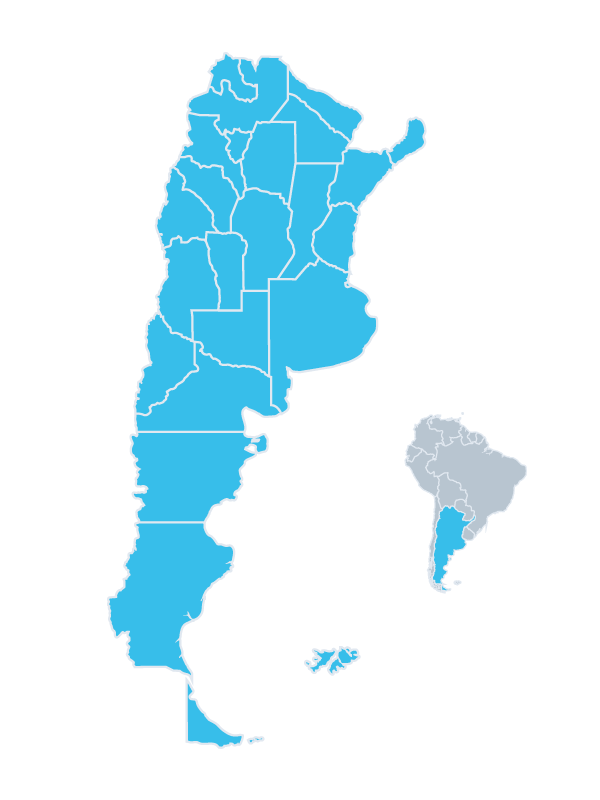Cuyo: Land of Hills & Wine
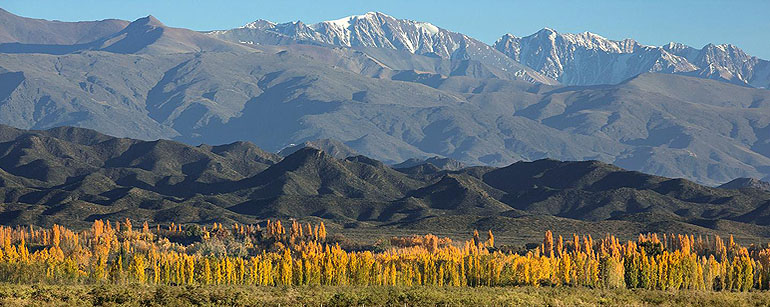
Better known as the region of the high peaks, its geography is made of snowy volcanoes and vast roads that spread from the Andes and the lower parts of the highlands to the plain of the steppes.
The so-called Moon Valley, in the province of San Juan is a palaeontology site full of amazing shapes and colors and a landscape formed through million years of erosion.
La Rioja, its neighbor province, offers the Canyon of the Talampaya River, which astonishes the visitors with the multifarious folds of its high and reddish walls. The region receives from its peaks three important rivers (San Juan, Mendoza and Tunuyán rivers) which make an oasis that has been transforming in a region of outstanding grapevine production and that nowadays has a singular route of wine, internationally recognized and known.
Mendoza province is the most important wine center of the country and one of the most outstanding of the world, concentrating the 70 % of the national production of wine. Connected to this activity several interesting alternatives have been developed to visit and cover vineyards, wine cellars and different places of vine production. Most of its cellars offer visits and food tastings. Following this concept, some places have built rooms for tourists, offering thus the experience of spending some days in the country houses, among beautiful and remote landscapes, while enjoying the peace of the place and tasting the regional food which is served with the best local wines. Mendoza city, capital of the homonym province, is a quiet city of clean streets where squares are located at the foot of the Andes Mountain Range, and between these mountains the highest peak of America stands: the Aconcagua mount (4350 miles high). Among other curiosities that can be found are the 313 miles of irrigation channels that line its streets. Nowadays Mendoza city It has an intense cultural life with its universities, theatres, amphitheaters, museums and art galleries. Its huge green and open spaces, like the San Martin Park and the view of the imposing Andean landscapes transform Mendoza into a very attractive city to the visitors. In wintertime, its ski centers are crowded with fans of this sport.
We recommend autumn, winter and spring as ideal seasons.
What can we do there?
-
Visit of Mendoza city and surrounding areas
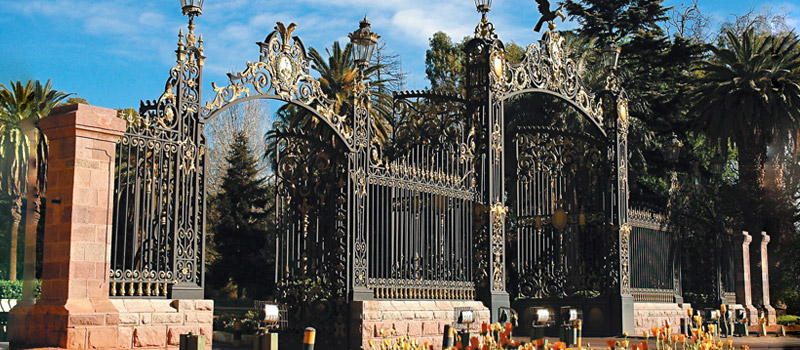
Duration: 4 hours
It is a tour about the history and culture of the community founded by the settlers more than four centuries ago. We visit La Alameda, the foundational area (Pedro del Castillo square), the Aquarium, the serpentarium, main avenues, Independencia square, the Civic Neighborhood and Emilio Civil avenue, road that lead us to the General San Martin Park through the Portones area. Over there we cover the rose garden, the lake, its little forests and clubs until we climb the Glory Hill with its imposing monument to the Liberator Army.
-
High Mountain
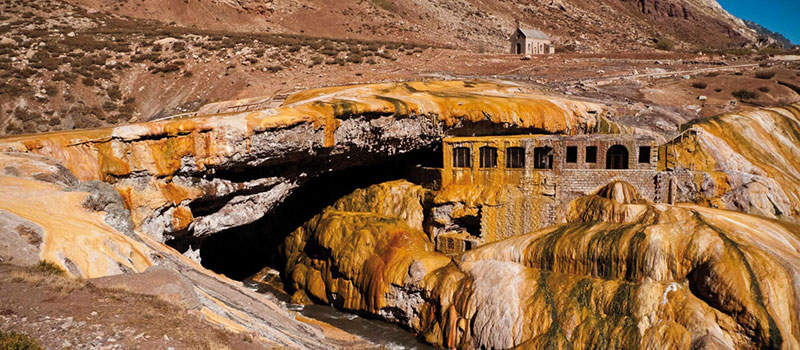
Duration: 12 hours
It is a traditional tour that starts in the Mendoza center of the city and finishes in the Chile border, covering the lower parts of the Highlands beside the Mendoza river. During the tour the giant Potrerillos dam can be appreciated. 62.5 miles away from the capital city is located Uspallata city, scenery of the Huarpe Indian settlement in the Prehispanic age. Before reaching the border, we will reach a natural viewpoint that offers a magnificent view of the Aconcagua Hill. Further on we will arrive at Puente del Inca (Inca Bridge), 2.720 meters over the sea level, where Las Cuevas river has perforated the mountain forming a natural bridge; thermal water can be found beside that bridge. Between Las Cuevas and the international tunnel that leads to Chile there is a road that – if the weather is good- allows the climbing to the Cristo Redentor’s monument, located 4.200 meters high (a symbol of the fraternity between Chileans and Argentineans). This tour offers the possibility to continue travelling to Chile, crossing the international bridge that communicates Argentina with Chile and leads towards Santiago de Chile city.
-
Wine Trips
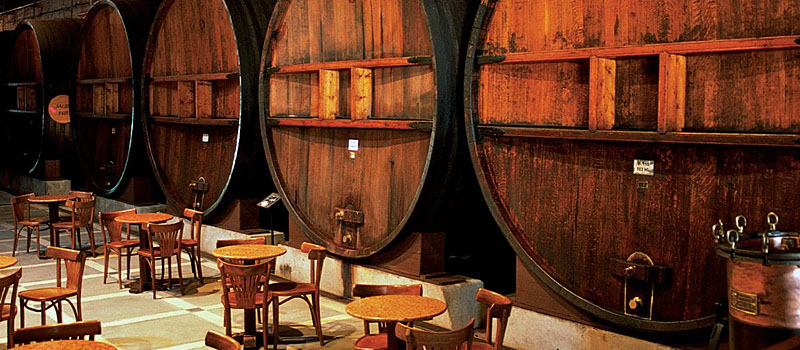
Mendoza province is the most important wine center of the country and one of the most outstanding of the world, concentrating the 70 % of the national production of wine. Connected to this activity several interesting alternatives have been developed to visit and cover vineyards, wine cellars and different places of vine production. Most of its cellars offer visits and food tastings. Following this concept, some places have built rooms for tourists, offering thus the experience of spending some days in the country houses, among beautiful and remote landscapes, while enjoying the peace of the place and tasting the regional food which is served with the best local wines.
-
The Roads of Wine
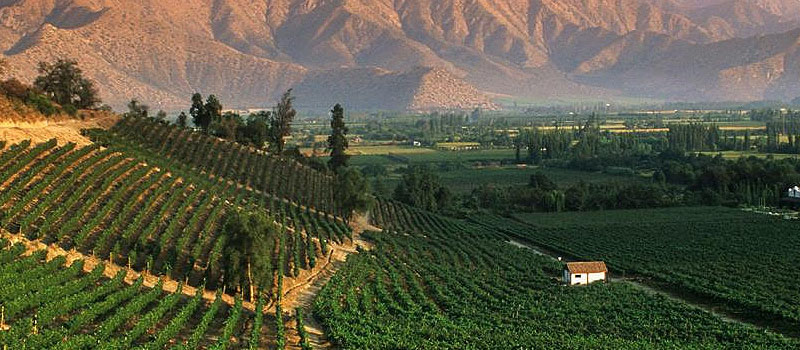
It consists of a visit of two or more wine cellars, where some wine experts will explain the wine production process. This visit also includes walks into the vineyards, and allows to go deep into the origin of this delicious elixir and to taste a regional barbecue, along with the tasting of several types of wines. During the visit you will be able to observe how the effort of men has transformed the desert into an oasis, with channels and irrigation ditches that exist from the Indian age and which nowadays with the aid of the computerized drip irrigation have put Argentina among one of the main wine manufacturers of the world, with an outstanding and growing quality of product.
-
Talampaya
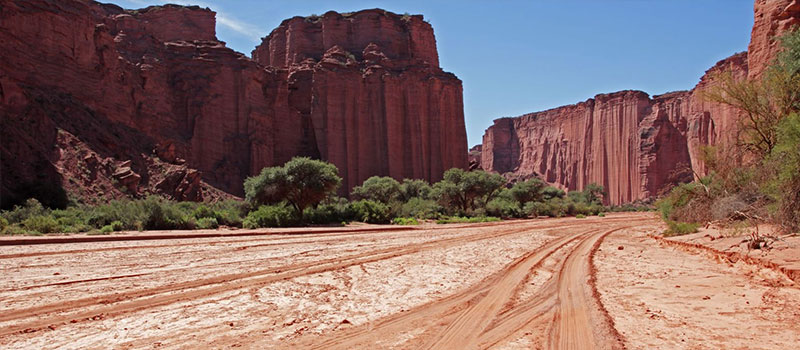
This national park, located at the south center of La Rioja province, belongs to the same basin “Valle de la Luna”, in the province of San Juan. Both of them have been declared by UNESCO as Natural Patrimony of Humanity.
The dry bed of the Talampaya River, surrounded by huge reddish walls of almost 150 metres high can be covered using specialized vehicles, adapted for the area. The erosion of thousand years has been sculpting amazing shapes over the walls that surround the canyon, generating a ghostly sense of immensity which is impossible to describe.
The park has an extremely important archaeological patrimony: the Petroglyph – engraved on stone- (made by the pre – Columbian cultures). They expose, over a dark background, millennial drawings and geometrical figures (spirals, moulds of human foot with six toes, flames, men and even curious beings with wings). In spite of the rough climate, one can observe animals of the region, such as gray foxes and the great character of the park, the Andean condor, which can be admired flying effortless at high places. Guanacos and maras can be easily observed too.
-
Moon Valley (Ischigualasto)
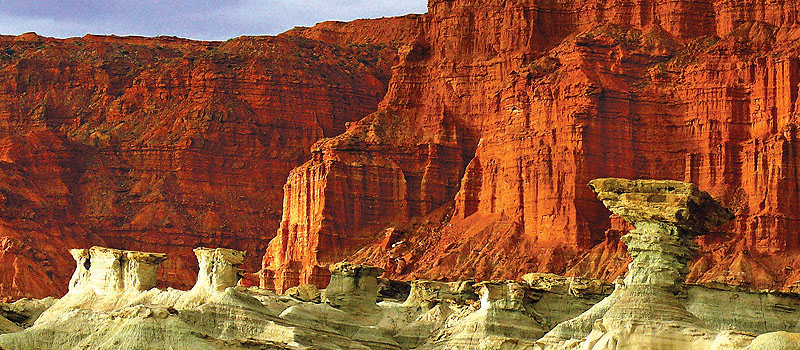
This provincial park, better known as Valle de la Luna (Moon Valley), is one of the most important paleontology beds of the world. Scientists and experts have searched this spot – unique and wonderful – to find answers to the eternal mysteries about the origin of dinosaurs and modern mammals. It covers 15.7 miles long and 6.25 wide and is located to the north west of the San Juan Province (department of San Agustín de Valle Fértil).
Along the route, some remains of vertebrates that inhabited the place 180 million years ago, during the Mesozoic age, can be observed. In addition, one can find footprints tracks of saurians, fern drafts and trunks of petrified Cook Pines, which are highly outstanding because of their scientific importance and relevance in a world level. Thus, the visitors will be able to know more about the 45 million years of geological evolution in the whole Ischigualasto basin, including the visits to the places of fossils extraction, accompanied by specialized guides.
Million years ago this region was a lake with plentiful vegetation, favorable for the life of different species of vertebrates. Today, the climate is desert, slightly rainy. It generally rains during summer and rain comes with strong winds and extreme temperatures.


